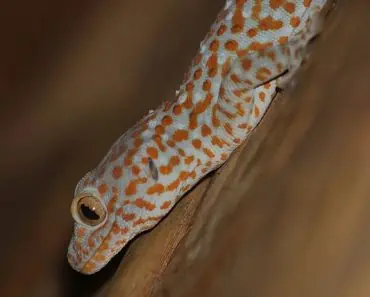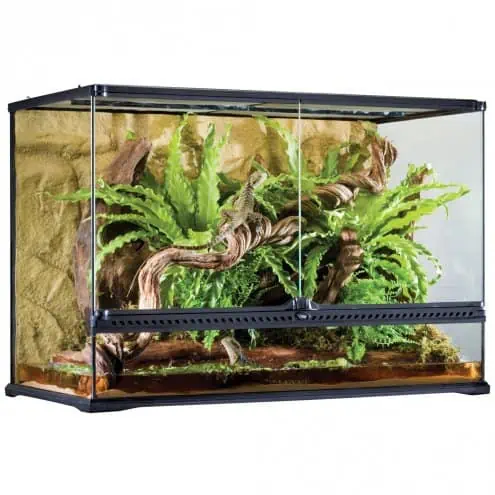Today, we’re going to take a close look at one of the most vibrant and intriguing species in the gecko family – the Tokay Gecko. Recognizable by their striking blue-gray bodies spotted with vibrant red or orange spots, these nocturnal climbers are a sight to behold.
Tokay Geckos are arboreal creatures, meaning they’re adapted to a life spent among the branches and leaves. Their natural habitat is rife with opportunities to climb, leap, and explore – and it’s our responsibility as caregivers to replicate this environment as closely as we can at home.
But why is this so important? And how do you go about creating a climbing-friendly habitat for your Tokay Gecko? That’s exactly what we’re going to delve into in this article.
We’re going to explore the specifics of their natural habitat, understand why climbing is so essential for these creatures, and guide you on setting up and maintaining a habitat that meets their climbing needs.
Tokay Gecko’s Natural Habitat
To set up a habitat that truly caters to the needs of your Tokay Gecko, it’s crucial to first understand their natural environment. Originating from Southeast Asia, Tokay Geckos are accustomed to humid, tropical rainforests, filled with lush vegetation and towering trees. The dense canopy provides numerous vertical spaces for them to climb and explore, while the humid climate keeps them hydrated and supports their skin health.
Tokay Geckos are most active during the night, making them a nocturnal species. They utilize the darkness to hunt for insects and avoid predators. During the day, they prefer hiding in crevices, tree barks, or foliage, hence the need for a diverse, multi-level environment.
In nature, Tokay Geckos are seen to ascend trees and leap from branch to branch, showcasing their strong affinity for climbing. This propensity for heights isn’t just for show—it’s integral to their survival and wellbeing. They rely on vertical spaces to evade predators, hunt prey, and engage in natural behaviors such as shedding skin.
This understanding of their natural habitat underpins the approach you should take while creating their home environment. The habitat you set up should be a microcosm of their wild, tropical home – ensuring enough vertical spaces for climbing, providing suitable hiding spots, and maintaining optimal humidity.
The Importance of Climbing for Tokay Geckos
Climbing isn’t just a pastime for Tokay Geckos—it’s an integral part of their lifestyle, health, and happiness. Let’s delve into why this aspect of their behavior is so important.
Firstly, it’s all about physical health. Regular climbing exercises different muscle groups in Tokay Geckos, keeping them strong and fit. This exercise helps maintain their agility, which is critical for hunting and avoiding predators in the wild. In a captive setting, it aids in preventing obesity—a common issue in domestic geckos—and other health complications linked to sedentary lifestyles.
Secondly, climbing holds great behavioral significance. Geckos are territorial creatures, and they often use elevated spaces to establish and maintain territories. Climbing also stimulates their natural instincts—like hunting and exploring—which can reduce stress and contribute to their overall wellbeing.
Lastly, climbing helps Tokay Geckos in their shedding process. Geckos naturally climb and rub against rough surfaces to aid in shedding their old skin. If they can’t do this effectively, they may experience improper shedding, leading to health issues such as retained shed, which can be particularly problematic around the toes and tail.
Components of a Climbing-friendly Habitat
Now that we’ve established the significance of climbing for Tokay Geckos, let’s break down the elements that contribute to making a habitat that’s not just safe, but climbing-friendly.
Vertical Space: Since Tokay Geckos love to climb, they require more vertical space than horizontal. A tall terrarium is a must, providing ample room for your gecko to ascend and descend. The enclosure should be large enough to create a diverse, multi-tiered environment that mimics the vertical complexity of a rainforest.
Substrate: A suitable substrate adds to the natural feel of the habitat and aids in maintaining humidity. Coconut fiber or orchid bark are excellent options that mimic the natural soil of a rainforest.
Branches and Vines: Introducing various climbing structures such as branches, vines, or even bamboo poles is key. They should be sturdy and well-secured to handle your gecko’s weight. Natural branches with different girths also encourage muscle development as your gecko navigates these structures.
Plants: Live or artificial plants add complexity to the environment and provide additional climbing surfaces. They also offer places to hide, contributing to your gecko’s sense of security.
Hides: Vertical hides that can be placed at different levels of the enclosure give your gecko places to rest and feel safe. These can be cork bark rounds, coconut hides, or any other reptile-safe material.
Humidity: Tokay Geckos thrive in high humidity levels, typically between 70-80%. A proper humid hide and regular misting can help achieve this environment.
By incorporating these elements, you’re well on your way to creating a climbing-friendly habitat.
Setting Up the Habitat for Climbing
Now that we’ve got the necessary components, it’s time to arrange them effectively to ensure your Tokay Gecko can get the most out of its climbing adventures.
- Start with the Substrate: Lay out your substrate evenly on the floor of the enclosure. Make sure it’s deep enough to retain moisture, but not so deep that it risks burying any food or causing clutter at the bottom of the terrarium.
- Install Branches and Vines: Arrange your branches, vines, or bamboo poles in a manner that creates multiple levels and routes for your gecko to explore. Secure them tightly to the enclosure to ensure they can bear the weight of your gecko. Remember to provide varying thicknesses and angles for an authentic experience.
- Position the Plants: Add your live or artificial plants next. They should provide extra climbing surfaces, additional cover, and bring a touch of greenery that simulates their natural environment.
- Place the Hides: Set up the hides at various heights. They should offer a secure and comfortable resting place for your gecko. Ensure the hides have at least two exit points to prevent your gecko from feeling trapped.
- Set Up the Humidity System: You might want to install a reptile fogger or mister to maintain high humidity levels. You can also manually mist the enclosure, but do remember that consistent humidity is key.
- Safety Check: Lastly, inspect your setup. Check if all structures are secured, and there are no sharp edges that could injure your gecko. Ensure there’s enough climbing space and the habitat doesn’t feel cluttered.
Maintaining and Monitoring the Habitat
Setting up the perfect habitat is only half the battle won. To ensure your Tokay Gecko continues to enjoy and benefit from its climbing-friendly habitat, regular maintenance and monitoring are crucial.
Regular Cleaning: Your gecko’s habitat should be cleaned regularly to prevent the buildup of harmful bacteria or fungi. This includes spot-cleaning for waste and a deep clean of the entire enclosure every few weeks. Don’t forget to clean the climbing structures too!
Humidity Checks: Regularly monitor the humidity levels within the enclosure. If it gets too low, your gecko may experience shedding issues; too high, and you risk encouraging mold growth. Daily misting and a high-quality hygrometer can help manage this.
Structural Safety: Over time, the climbing structures might loosen or wear out. Regularly check for any signs of damage or instability. Re-secure or replace them as necessary.
Monitor Your Gecko’s Behavior: Pay close attention to your Tokay Gecko’s behavior. Are they climbing frequently? Do they have a favorite perch? Are they avoiding certain areas? Your gecko’s behavior can give you insights into any changes that might be needed in the setup.
Veterinary Checks: Regular health check-ups with a reptile vet will ensure your gecko is in good health and not suffering from any unseen issues.
Through continuous maintenance and monitoring, you can ensure that your gecko’s habitat remains a safe, enriching, and climbing-friendly environment.
Spotting Problems and Trouble-shooting
Despite your best efforts, you might encounter a few bumps along the road. Don’t worry, though, as these are typically easy to spot and rectify.
Low Activity: If your gecko is not climbing or exploring as much as expected, it might be due to stress, illness, or an unsatisfactory setup. Review your habitat for any possible issues and consult a vet if necessary.
Falling Decor: If your branches, vines, or other climbing structures fall often, they might not be secure enough. Revisit your setup and ensure everything is firmly fixed.
Poor Shedding: If your gecko is having trouble shedding, it could be due to low humidity. Make sure you’re maintaining appropriate humidity levels and provide a moist hide to aid in shedding.
Avoiding Certain Areas: If your gecko avoids certain parts of the habitat, it could be because they feel exposed or insecure. Re-evaluate your setup to provide more cover or hiding spots.
Injuries: In case of any injuries, seek immediate veterinary help. Adjust your habitat to prevent any recurrence, and always remove any sharp or rough objects that could harm your gecko.
Remember, it’s normal to experience hiccups while caring for a live creature. The key is to observe, learn, and adapt your care to ensure your Tokay Gecko can climb and explore to their heart’s content.
Conclusion
There you have it, the complete guide to optimizing your Tokay Gecko’s habitat for climbing. We’ve journeyed from understanding their natural habitat, highlighting the importance of climbing for these vibrant creatures, to setting up and maintaining a suitable habitat. Remember, creating a climbing-friendly environment isn’t just about installing a few branches—it’s about understanding your gecko’s needs, replicating their natural environment, and ensuring their overall wellbeing.
The key takeaway here is to keep things as natural and engaging as possible. Observe your gecko and adapt the habitat according to their preferences. With patience and a bit of creativity, you’ll soon have a setup where your Tokay Gecko can happily explore, climb, and thrive!
Frequently Asked Questions (FAQs)
What materials can I use for climbing structures?
You can use a variety of materials such as real branches, artificial vines, bamboo poles, or reptile hammocks. Just ensure they’re non-toxic, sturdy, and securely installed.
How often should I mist the enclosure?
This depends on your specific enclosure and its ability to retain humidity. As a general rule, misting once or twice daily is usually sufficient for maintaining proper humidity levels.
My gecko isn’t climbing much. What’s wrong?
There could be several reasons, ranging from health issues to a poorly arranged habitat. Consult with a vet to rule out any health problems and revisit your habitat setup to ensure it is optimally arranged for climbing.
Can I use live plants in my gecko’s habitat?
Yes, you can! Live plants can improve the aesthetic of the enclosure, increase humidity, and provide more natural climbing and hiding spots. Just make sure the plants are safe for geckos and free from pesticides.






